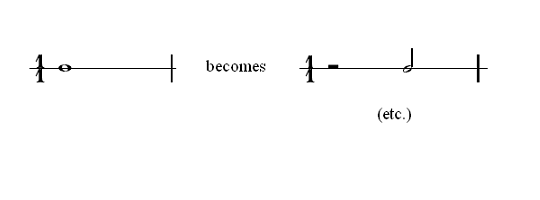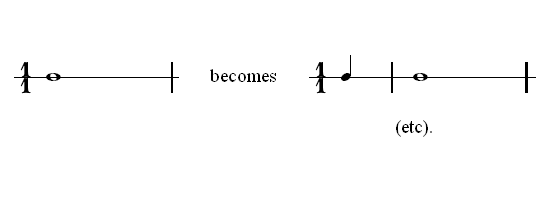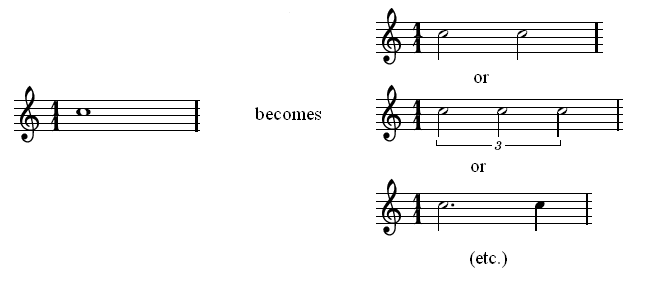
Peter Westergaard's Tonal Theory
Encyclopedia
Peter Westergaard's tonal theory is the theory
of tonal music
developed by Peter Westergaard
and outlined in Westergaard's 1975 book An Introduction to Tonal Theory (hereafter referred to as ITT). Based on ideas of Heinrich Schenker
(see Schenkerian analysis
), Westergaard's theory is notable for:
, as opposed to one dealing with acoustics
or neurophysiology
. The argument he gives for defining the domain of inquiry in this way is essentially the following: on the one hand, the acoustics of music are already well understood, and in any case acoustical theories are of limited use in addressing the psychological
aspects of the musical experience; on the other hand, while neuroscience
may eventually be capable of addressing these latter aspects, it is not currently equipped to do so—a situation which is unlikely to change in the near future. Consequently, our best strategy is to address the psychological questions directly, more or less at the level of introspection
(ITT, pp. 3–7).
Such an approach, however, immediately raises the problem of developing a metalanguage
for discussing tonal music: how do we accurately describe "what we hear"? Reasoning that the process of solving this problem will itself lead inevitably to substantive insights into how music is actually heard, Westergaard takes the construction of a metalanguage for tonal music as his task for the main part of the book (ITT, pp. 7–9).
, onset time, duration, loudness
, and timbre
. The core of Westergaardian theory consists of the following two claims about notes (Peles 1997, p. 74; ITT, p. 375):
In accordance with the second fundamental claim of Westergaard's theory (see above), applying the operations to given notes should produce other notes that are understood by the listener as being derived from the given notes. One is thus obliged to deal with the question of structural ambiguity: by what means can the composer ensure that the listerner understands the particular subordination relations that were intended? Describing potentially ambiguous situations, and the means of resolving them, is one of the major themes of Westergaardian theory, and this preoccupation is evident throughout ITT.
The onset time of a note may be delayed to a later time-point:

A note may be anticipated by another note whose time-span is conceptually subordinate to that of the original note:

A note in a line may be split into a sequence of successive notes such that:

This process (along with its result) is called rearticulation (ITT, p. 35). Although repeated notes may result from an anticipatory structure as well as one derived by segmentation (ITT, p. 35), Westergaard does not use the term "anticipatory rearticulation", preferring instead to simply call such structures "anticipations".
A neighbor structure is constructed from a rearticulation by:

The new note is referred to as a neighbor of the original two. Unlike the ordinary use of the word "neighbor", this relationship is not reciprocal (ITT, p. 35).
Incomplete neighbors may be used to anticipate or delay a note:

Borrowing/Arpeggiation
A note may be borrowed from another (conceptual) line:

The borrowed note need only be a member of the same pitch-class as the source; it does not have to be in the same octave:

Borrowings may of course be anticipatory:

N.B.: It is largely this operation which replaces harmony
in Westergaardian theory (Peles 1997, p. 79).
Theory
The English word theory was derived from a technical term in Ancient Greek philosophy. The word theoria, , meant "a looking at, viewing, beholding", and referring to contemplation or speculation, as opposed to action...
of tonal music
Tonality
Tonality is a system of music in which specific hierarchical pitch relationships are based on a key "center", or tonic. The term tonalité originated with Alexandre-Étienne Choron and was borrowed by François-Joseph Fétis in 1840...
developed by Peter Westergaard
Peter Westergaard
Peter Talbot Westergaard is an American composer and music theorist. He is Professor Emeritus of music at Princeton University.-Biography:...
and outlined in Westergaard's 1975 book An Introduction to Tonal Theory (hereafter referred to as ITT). Based on ideas of Heinrich Schenker
Heinrich Schenker
Heinrich Schenker was a music theorist, best known for his approach to musical analysis, now usually called Schenkerian analysis....
(see Schenkerian analysis
Schenkerian analysis
Schenkerian analysis is a method of musical analysis of tonal music based on the theories of Heinrich Schenker. The goal of a Schenkerian analysis is to interpret the underlying structure of a tonal work. The theory's basic tenets can be viewed as a way of defining tonality in music...
), Westergaard's theory is notable for:
- explicit treatment of the relationship between rhythmRhythmRhythm may be generally defined as a "movement marked by the regulated succession of strong and weak elements, or of opposite or different conditions." This general meaning of regular recurrence or pattern in time may be applied to a wide variety of cyclical natural phenomena having a periodicity or...
ic structures and pitchPitch (music)Pitch is an auditory perceptual property that allows the ordering of sounds on a frequency-related scale.Pitches are compared as "higher" and "lower" in the sense associated with musical melodies,...
structures in tonal music; and - elimination of "harmonyHarmonyIn music, harmony is the use of simultaneous pitches , or chords. The study of harmony involves chords and their construction and chord progressions and the principles of connection that govern them. Harmony is often said to refer to the "vertical" aspect of music, as distinguished from melodic...
" as a conceptually independent element of musical structure (in Westergaard's theory, traditional "harmonic" principles follow as by-products, or epiphenomenaEpiphenomenonAn epiphenomenon is a secondary phenomenon that occurs alongside or in parallel to a primary phenomenon.-Medicine:...
, of more fundamental contrapuntalCounterpointIn music, counterpoint is the relationship between two or more voices that are independent in contour and rhythm and are harmonically interdependent . It has been most commonly identified in classical music, developing strongly during the Renaissance and in much of the common practice period,...
principles, so that discussion of chord progressions as such becomes superfluous).
Methodological foundations
In keeping with Westergaard's characteristic "concern with fundamental methodological questions" (Peles 1997, p. 75), ITT begins with a discussion of what it is that a theory of tonal music consists of. The conclusion reached is that it is a "logical framework in terms of which we understand tonal music" (ITT, p. 9)--the operative words being "we understand". Westergaard is thus seeking a theory about a certain kind of cognitionCognition
In science, cognition refers to mental processes. These processes include attention, remembering, producing and understanding language, solving problems, and making decisions. Cognition is studied in various disciplines such as psychology, philosophy, linguistics, and computer science...
, as opposed to one dealing with acoustics
Acoustics
Acoustics is the interdisciplinary science that deals with the study of all mechanical waves in gases, liquids, and solids including vibration, sound, ultrasound and infrasound. A scientist who works in the field of acoustics is an acoustician while someone working in the field of acoustics...
or neurophysiology
Neurophysiology
Neurophysiology is a part of physiology. Neurophysiology is the study of nervous system function...
. The argument he gives for defining the domain of inquiry in this way is essentially the following: on the one hand, the acoustics of music are already well understood, and in any case acoustical theories are of limited use in addressing the psychological
Psychology
Psychology is the study of the mind and behavior. Its immediate goal is to understand individuals and groups by both establishing general principles and researching specific cases. For many, the ultimate goal of psychology is to benefit society...
aspects of the musical experience; on the other hand, while neuroscience
Neuroscience
Neuroscience is the scientific study of the nervous system. Traditionally, neuroscience has been seen as a branch of biology. However, it is currently an interdisciplinary science that collaborates with other fields such as chemistry, computer science, engineering, linguistics, mathematics,...
may eventually be capable of addressing these latter aspects, it is not currently equipped to do so—a situation which is unlikely to change in the near future. Consequently, our best strategy is to address the psychological questions directly, more or less at the level of introspection
Introspection
Introspection is the self-observation and reporting of conscious inner thoughts, desires and sensations. It is a conscious and purposive process relying on thinking, reasoning, and examining one's own thoughts, feelings, and, in more spiritual cases, one's soul...
(ITT, pp. 3–7).
Such an approach, however, immediately raises the problem of developing a metalanguage
Metalanguage
Broadly, any metalanguage is language or symbols used when language itself is being discussed or examined. In logic and linguistics, a metalanguage is a language used to make statements about statements in another language...
for discussing tonal music: how do we accurately describe "what we hear"? Reasoning that the process of solving this problem will itself lead inevitably to substantive insights into how music is actually heard, Westergaard takes the construction of a metalanguage for tonal music as his task for the main part of the book (ITT, pp. 7–9).
Outline of the theory
Music is conceived of as consisting of discrete atoms called notes. By definition, these are (conceptual) units of sound that possess the following five attributes: pitchPitch (music)
Pitch is an auditory perceptual property that allows the ordering of sounds on a frequency-related scale.Pitches are compared as "higher" and "lower" in the sense associated with musical melodies,...
, onset time, duration, loudness
Dynamics (music)
In music, dynamics normally refers to the volume of a sound or note, but can also refer to every aspect of the execution of a given piece, either stylistic or functional . The term is also applied to the written or printed musical notation used to indicate dynamics...
, and timbre
Timbre
In music, timbre is the quality of a musical note or sound or tone that distinguishes different types of sound production, such as voices and musical instruments, such as string instruments, wind instruments, and percussion instruments. The physical characteristics of sound that determine the...
. The core of Westergaardian theory consists of the following two claims about notes (Peles 1997, p. 74; ITT, p. 375):
- Starting from a specific type of primitive structure (a diatonic collection with an associated "tonicTonic (music)In music, the tonic is the first scale degree of the diatonic scale and the tonal center or final resolution tone. The triad formed on the tonic note, the tonic chord, is thus the most significant chord...
" triadTriad (music)In music and music theory, a triad is a three-note chord that can be stacked in thirds. Its members, when actually stacked in thirds, from lowest pitched tone to highest, are called:* the Root...
; see below), we can generate all the notes of any tonal piece by successive application of a small set of operations. - The successive stages in the generation process show how we understand the notes in terms of each other.
Generative operations
Every note is associated both with a particular pitch and a particular time-span (the interval of time between the moment when the note begins and the moment when it ends). Westergaardian operations on notes may be described as composite in nature: they consist of operations on time-spans, onto which operations on pitches are superimposed. (One can think of the time-span operations as accommodating the pitch operations.)In accordance with the second fundamental claim of Westergaard's theory (see above), applying the operations to given notes should produce other notes that are understood by the listener as being derived from the given notes. One is thus obliged to deal with the question of structural ambiguity: by what means can the composer ensure that the listerner understands the particular subordination relations that were intended? Describing potentially ambiguous situations, and the means of resolving them, is one of the major themes of Westergaardian theory, and this preoccupation is evident throughout ITT.
Delay
The onset time of a note may be delayed to a later time-point:

Anticipation
A note may be anticipated by another note whose time-span is conceptually subordinate to that of the original note:

Rearticulation
A note in a line may be split into a sequence of successive notes such that:
- the durations of all of the notes together equal the duration of the original note;
- all of the notes have the same pitch as the original note; and
- the first note begins at the same moment in time the original note began.

This process (along with its result) is called rearticulation (ITT, p. 35). Although repeated notes may result from an anticipatory structure as well as one derived by segmentation (ITT, p. 35), Westergaard does not use the term "anticipatory rearticulation", preferring instead to simply call such structures "anticipations".
Neighbors
A neighbor structure is constructed from a rearticulation by:
- dividing the time-span of the first note into two segments, and
- inserting, in the second segment, a note whose pitch is an adjacent member of the appropriate diatonic collection (while leaving a note of the original pitch to occupy the first segment).

The new note is referred to as a neighbor of the original two. Unlike the ordinary use of the word "neighbor", this relationship is not reciprocal (ITT, p. 35).
Incomplete neighbors may be used to anticipate or delay a note:

Borrowing/ArpeggiationArpeggioAn arpeggio is a musical technique where notes in a chord are played or sung in sequence, one after the other, rather than ringing out simultaneously...
A note may be borrowed from another (conceptual) line:

The borrowed note need only be a member of the same pitch-class as the source; it does not have to be in the same octave:

Borrowings may of course be anticipatory:

N.B.: It is largely this operation which replaces harmony
Harmony
In music, harmony is the use of simultaneous pitches , or chords. The study of harmony involves chords and their construction and chord progressions and the principles of connection that govern them. Harmony is often said to refer to the "vertical" aspect of music, as distinguished from melodic...
in Westergaardian theory (Peles 1997, p. 79).

